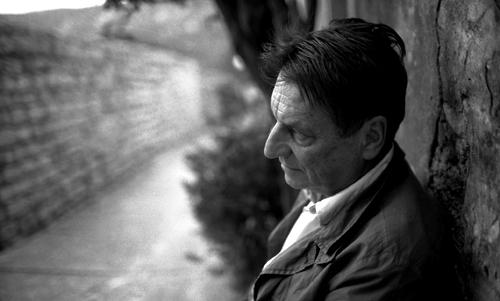
Claudio Magris - The salt of the earth

Danilo De Marco reminds us that the human face resembles that of the earth. The human faces prevailing in his photographs, faces with an epic history of pain and dignity written on them - are marked by lines as the fields are marked by ploughs dripping with sweat, they have been etched by natural and social elements like tree trunks gnarled by rain, lit by light smiles shining like a water spring or a clear windy sky.
De Marco is poet and a narrator of the dignity of human kind, of his humility, in the etymological sense of the word deriving from the Latin humus, soil. De Marco reminds us - with the direct physical simplicity of poetry, without the need for lectures or ideological proclamations - that human kind, as Genesis tell us, was moulded from the earth and therefore can share in its bounty and dignity.
De Marco searches for such qualities where one might think it impossible to find them in faces disfigured and rendered unrecognisable by pain. He has gone looking for these qualities and found them in the anguished faces of Mexican peasants, in those of the haunted and massacred Kurds, in the Chinese and Tibetans threatened by poverty and oppression; in the faces of the Parisian Sans papiers, who are subjected to a life of exile and the universal human condition of feeling a nobody; in the Brazilian Sem Terra (landless), deprived of everything and exposed to every kind of shameful brutality.
His photographs are a representation of hope and utopia. The majority of men, women, old and children portrayed by Danilo are “creatures” who live in unbelievable conditions of suffering and privation, crushed by centuries of poverty, a poverty still painfully current; people suppressed by a nameless violence inflicted by the exploitation of masters, slave-drivers, governments and rules of every kind, all ruthless plunderers.
One might think that these people who have been robbed and continue to be robbed of all they have, who continue to be brutalised, tortured and even murdered, people whose lives have stolen or expropriated, might have become ugly, lifeless, dehumanised, as injustice and violence often make beasts of their victims.
This is precisely why we must fight against injustice and violence and set their victims both materially and spiritually free and return their stolen and disfigured humanity, their oppressed human nature. On those faces, De Marco uncovers and frees, like a benevolent wizard, an incorruptible humanity and dignity, an indestructible power and life.
In the work of Danilo these “damned” faces of the earth, belonging to people on the fringes of civilisation, society and culture, are the portrait of human condition.
These are the real faces of humankind against which other people’s faces are compared - faces not only belonging to their infamous persecutors, but also those average, banal, conventional, respectable faces - our own.
Compared to theirs our faces are mask-like, borrowed, anonymous faces, interchangeable like well-cut hats. The faces of those who do not really live their lives, but play a role on someone else’s behalf, like stand-ins in a movie.
De Marco’s faces are of generous, indomitable, sacred old men made of stone; women breast-feeding their babies - images of Mary like no others - and children whose smiles are as charming and as majestic as a sunrise. They are the Salt of the Earth.
They stand - with their simple gestures, with their string and loving hands, with their meaningful possessions - above their despicable exploiters and tyrants.
They are oppressed but not defeated; they are warriors; as tenacious as water, they are real men. Looking at their pictures, one wonders if, after all, the phrase from the Gospel that says those who come last will come first, could not but be true.
De Marco’s photographs are creative images, but faithful to the world, not arbitrary or speciously constructed and they are proof that hope still exists, they are a demonstration that utopia, human improvement and redemption are a wild fancy, but a reality. Photography shows their existence, it is proof of their existence before the Court of History. He captures the spiritual sense of humankind, which is inextricably linked with this precise social portrayal, a portrayal which reveals injustice and pulls no punches. Those are unmistakably individual faces which are, at the same time, fraternally united in a harmonious blend of elements; not in the colourful yet regressive togetherness of an ethnic group, of an exotic culture or in that of a minority patronized by rhetoric of the “small” or “different”, but in the simple, yet complex great human chorus. That brotherhood that unites them to the landscape is the mirror of our face, or rather it is our face itself; the ground where our life grows and finds its proportion and meaning.
